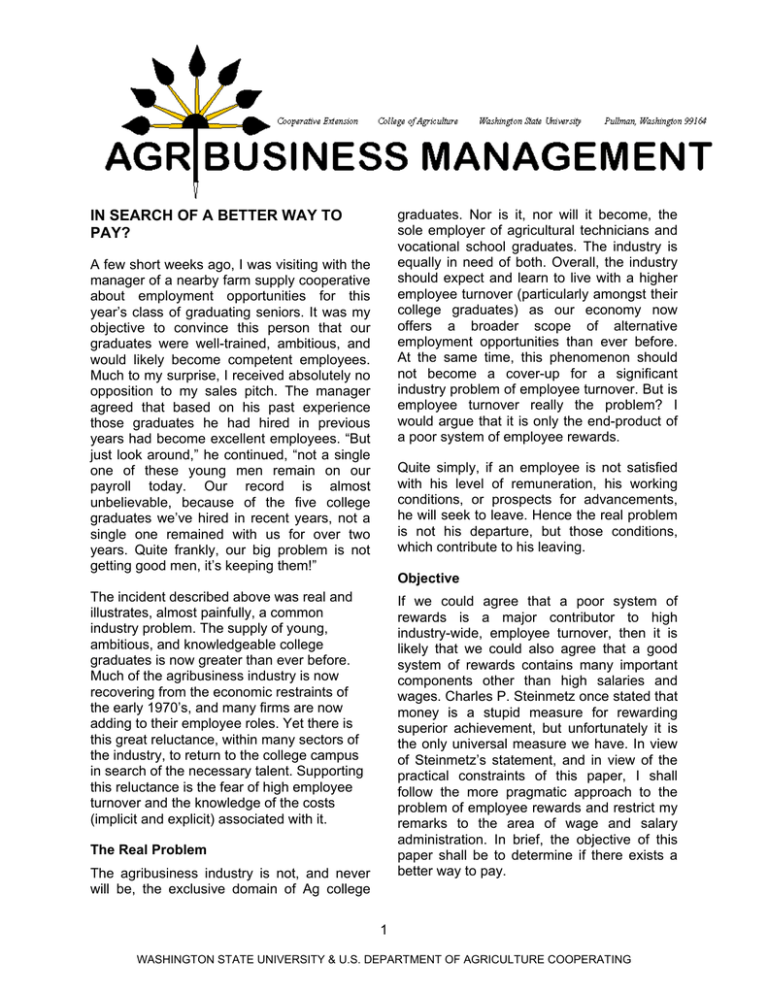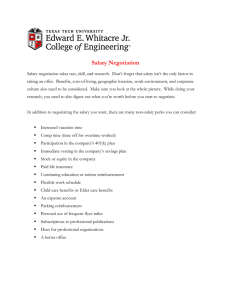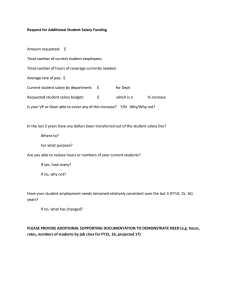IN SEARCH OF A BETTER WAY TO PAY?
advertisement

graduates. Nor is it, nor will it become, the sole employer of agricultural technicians and vocational school graduates. The industry is equally in need of both. Overall, the industry should expect and learn to live with a higher employee turnover (particularly amongst their college graduates) as our economy now offers a broader scope of alternative employment opportunities than ever before. At the same time, this phenomenon should not become a cover-up for a significant industry problem of employee turnover. But is employee turnover really the problem? I would argue that it is only the end-product of a poor system of employee rewards. IN SEARCH OF A BETTER WAY TO PAY? A few short weeks ago, I was visiting with the manager of a nearby farm supply cooperative about employment opportunities for this year’s class of graduating seniors. It was my objective to convince this person that our graduates were well-trained, ambitious, and would likely become competent employees. Much to my surprise, I received absolutely no opposition to my sales pitch. The manager agreed that based on his past experience those graduates he had hired in previous years had become excellent employees. “But just look around,” he continued, “not a single one of these young men remain on our payroll today. Our record is almost unbelievable, because of the five college graduates we’ve hired in recent years, not a single one remained with us for over two years. Quite frankly, our big problem is not getting good men, it’s keeping them!” Quite simply, if an employee is not satisfied with his level of remuneration, his working conditions, or prospects for advancements, he will seek to leave. Hence the real problem is not his departure, but those conditions, which contribute to his leaving. Objective The incident described above was real and illustrates, almost painfully, a common industry problem. The supply of young, ambitious, and knowledgeable college graduates is now greater than ever before. Much of the agribusiness industry is now recovering from the economic restraints of the early 1970’s, and many firms are now adding to their employee roles. Yet there is this great reluctance, within many sectors of the industry, to return to the college campus in search of the necessary talent. Supporting this reluctance is the fear of high employee turnover and the knowledge of the costs (implicit and explicit) associated with it. If we could agree that a poor system of rewards is a major contributor to high industry-wide, employee turnover, then it is likely that we could also agree that a good system of rewards contains many important components other than high salaries and wages. Charles P. Steinmetz once stated that money is a stupid measure for rewarding superior achievement, but unfortunately it is the only universal measure we have. In view of Steinmetz’s statement, and in view of the practical constraints of this paper, I shall follow the more pragmatic approach to the problem of employee rewards and restrict my remarks to the area of wage and salary administration. In brief, the objective of this paper shall be to determine if there exists a better way to pay. The Real Problem The agribusiness industry is not, and never will be, the exclusive domain of Ag college 1 WASHINGTON STATE UNIVERSITY & U.S. DEPARTMENT OF AGRICULTURE COOPERATING Destroying the Mystique Seeds of Discontent A certain mystique seems to shroud wage and salary administration throughout much of the industry. In my opinion, much of this mystique has been intentionally generated and used by management to protect and cushion the decision process from its own deficiencies and inequities. The intricacies of the remunerative reward system are kept so secret that its complexities confuse both employer and employees, alike. It’s likely that the current remunerative system is little more than a tedious exercise of abstract pronouncements and misunderstood myths. I am not suggesting that the wages and salaries of all employees be posted on the company’s bulletin board. Quite to the contrary, as there are numerous sound reasons why this information should remain confidential. The process by which wages and salaries are set and adjusted, however, should not be a deep secret but made well known to all employees. The above components would seem straightforward. Yet the wage and salary system designed to accommodate all four may provide the seeds of discontent. For example, many managers in an attempt to make the accommodation, develop a reward system that is technically contrived and rigidly structured. His foremen or line supervisors cannot understand it, they refuse to accept it, and they fail to administer it. The natural result is chaos amongst the rank and file. Instead, the system, while constructed in an orderly manner, should allow enough flexibility for supervisor discretion. After all, if the supervisors don’t trust the system they won’t use it, or if they do use it, the system will become the scapegoat in defense of the firm’s inability to satisfy an employee’s complaint about his compensation. Worse yet, some supervisors may actually look for loopholes in the system so they can tell their subordinates that pay decisions are made higher up in the administrative chain. This scheme gets the “monkey off their backs,” but also pushes the employee evaluative process out of the hands of the man most qualified to make the evaluation, i.e., the employee’s most immediate supervisor. It is very doubtful that I will attain full agreement with the reader throughout the entire length of this paper. Hence, it would seem wise to at least begin with some harmonious beliefs. I think we can all agree on several supporting reasons for having a good wage and salary reward system. They include: Wage and salary administration can get technical, particularly if the firm is large and employs several different classes of employees, e.g., laborers, technicians, secretarial, staff, professional, etc. Under such conditions, a number of internal considerations should be recognized. Internal equity (the relationship of pay between employees) is one of these most basic considerations. If employees believe inequities exist (even though they may not), they will quickly lose all their confidence in the reward system. Of course, they are equally sensitive about the level of pay for employees doing similar work in other (often competing) firms. Similar concern must be expressed relative to the uniform application of merit increases. Meritorious performance left unrecognized will contribute to the 1. A firm must be able to attract and retain qualified and competent employees if it is to remain a viable enterprise for very long. 2. There must exist an orderly system for motivating employees and rewarding meritorious performance so that the employees remain productive and efficient. 3. Internal equity between employees must be maintained in a systematic and fair manner. 4. Each firm must competitiveness. maintain external 2 dissipation encourage abounds. of employees’ moral and the notion that favoritism Common Industry Guides It is, of course, impossible to state that a particular personnel policy is “common” or “typical” of the agribusiness industry. The industry, itself, is so widely varied and the wage and salary policies so numerous that one is hard pressed to select guides that appear to be representative. Yet I have attempted to assemble such guides and each is discussed briefly below: Administrative Guides No reward system is perfect. Furthermore, you no doubt compared several alternative reward systems and wage and salary structures before selecting that which appeared most suitable to your operation. The complexity of wage and salary problems and the attendant difficulty in solving them is sufficient reason to develop a reasonably formalized reward system. Hiring Rates: If you have enough employees, such that a fairly complete salary structure is evident, it is advisable to hire between the minimum and the midpoint of the existing wage or salary range, depending on the prospective employee’s qualifications. On the theory that the midpoint represents the “going rate” for the job, this point should not be exceeded unless the prospective employee has unusual qualifications. Hiring higher in the range is also likely to result in problems of internal equity. In the rare case that you hired someone at below the minimum, it would be advisable to review his wage or salary at short (90 days), regular intervals. By a formalized system, I am not referring to a rigid program with long lists of acceptable personnel practices. Instead, I am referring to a set of established standards for guiding a manager’s decision relative to personnel matters. Such standards are meant to be flexible and should be in the form of policies and procedures, generally committed to writing, and intended as guides to reasonable decisions. I emphasize “guide” since they should not be so restrictive as to usurp managerial prerogatives and discretion. Communication of these policy guides down to the employees should remain open to promote understanding and acceptance. Records should always be kept to permit orderly comparisons for present and future decisions and in order to more accurately evaluate an employee’s historical relationship with the firm. This cannot be overemphasized because many times in my travels I contact managers who have actually forgotten when an employee or group of employees were last considered for a possible merit adjustment. Such records and written policy guides are also quite valuable to the manager in regard to his firm’s compliance with existing legal requirements. For example, Employment Security, Disability Coverage, Fair Labor Standards Act, Phase II, OSHA, labor negotiations, and many other similar legal constraints make it mandatory that a rather complete set of personnel records be maintained. Merit Increases: The key to a successful reward system - or the reason for failure of an unsuccessful one - is the manner in which merit increases are administered. In most firms in recent years there have been annual merit reviews with the amount of increase averaging 5 to 7 percent. Increases of less than 5 percent may have kept the employee “even” with the general cost-of-living but it probably had no motivational value (or perhaps a negative one). Compa-Ratio: A special tool for analyzing the effectiveness of reward systems is the “compa-ratio.” Quite simply, it’s the ratio between the average observed wage or salary and the midpoint of the established wage or salary range (for a given job or employee classification or grade). It would be calculated as: 3 reward when it occurs, or partially at that time with short-term continuing reviews. Average of All Observed Wages or Salaries in Grade × 100 = Compa-Ratio Midpoint of the Established Salary Range It is bad policy, in my opinion, to inform an employee of a promotion while holding back on the financial reward until some future time. Such a policy infers your lack of confidence in his ability to do the job while he is “on trial.” This ratio has significance where merit salary ranges are in use and where the midpoint of the established range is thought of by management as being a target average salary, i.e., a good competitive level which need not, on the average, be exceeded. A compa-ratio of near 100 suggests that the average salary is close to the midpoint of the range and the reward system is on target. In an established salary range where the maximum is 50 percent higher than the minimum, a compa-ratio of 80 will show that the average salary is identical with the minimum. A compa-ratio of 120 will show an average salary in line with the maximum. A normal industry variation in compa-ratio would be 95 to 105. In the more subtle type of promotion, an employee's responsibilities change gradually due mostly to his own improved proficiency on the job. Generally speaking, a merit increase is designed to reward such improvement. Yet in a practical sense, it is difficult to know when improved proficiency has ceased and a broadened employee responsibility begins. If the latter appears to evolve, a modest promotion increase would seem warranted in addition to the merit already earned. Downgrading: There are two conditions under which an employee’s remunerative rate becomes frozen. The first situation arises when an employee's abilities prove inadequate to meet the demands of job requirements. In this case, the pay is frozen because he is already being paid more than his performance is worth. The second situation arises as a result of technological change. Such technological innovations, when implemented, may simplify or reduce the employee’s responsibility to a point where the current rate of pay is no longer justified. Until such time as the entire pay structure moves up to allow further incremental progress, the downgraded position remains frozen at the current rate of pay. The compa-ratio has practical value in determining, within an established salary or wage structure, where money available for salary or wage increases should be spent. For example, a ratio of 100 suggests that remunerative levels are generally acceptable to most and the need for widespread increases is limited. A ratio of above 100, however, may suggest that wage or salary levels are riding too high OR, it may mean your firm is composed of established, experienced personnel, most of whom are now found in the upper brackets of the established wage or salary structure. A ratio of much below 100 suggests that some degree of underpayment is indicated in relation to competitive rates OR you have a relatively young and inexperienced personnel contingent. Cost-of-Living Increases: Earlier in this paper I suggested that a merit increase of less than 5 percent might have kept the employee “even” with the cost-of-living, but unmotivated as a worker. In recent years there has been a general trend within the agribusiness industry and others, which suggests that cost-of-living increases should become “automatic” or that the firm is obligated to its employees to at least keep them “even” with inflation. Such reasoning is, in my personal opinion, Promotion Increases: There are two types of situations wherein an individual's responsibilities can change. One is obvious, and the second is more subtle. In the first case, an employee moves to a distinctly different job at a higher pay rate. Such an obvious move should be recognized with a 4 affect the size of individual increases. Another simple control mechanism is the statistical analysis of actual experience. Reports on the average increase awarded, the average salary range in grade, average salaries paid, etc., help management to judge the viability of the current reward system. fallacious as it rests on the assumption that it is the employer’s fault that inflation continues. Proponents of such general, or cost-of-living, increase point to its effectiveness in keeping the employees “even.” However, they are also attracted to the clarity of communications without the pretense of equating economic increases with merit. The opponents contend that such general increases erode the system of pay based on performance. They consider them costly and a drain on funds otherwise available for merit recognition, while providing little if any motivation. Finally, the opponents argue, management often accepts the general increase on the false pretense that it promotes or retains internal harmony and makes their job easier by eliminating the need to conduct regular review of each employee’s performance. SUMMARY Keeping good employees is a significant problem to many firms within the agribusiness industry. Losing them can often be attributed to a bad or poorly operating employee reward system. This paper suggests that wage and salary administration is an often overlooked but vital function of management. It also suggests that in search of a better way to pay, management should implement a reward program designed to accomplish the following objectives: (1) reflect the firm’s management philosophy, (2) maintain a rational and practical hierarchy of job positions, (3) promote internal equity based on employee performance, (4) provide the firm with an ability to retain a competitive position in the employment market, and (5) enable management to retain control over an orderly employee reward program. In my personal view, I would prefer to deal with inflationary pressures within the all-merit system and discourage separate cost-of-living increases as an automatic or obligatory supplement to salary. This view is based on the following statements: 1. Unless the general increase exceeds the rise in the Consumer Price Index, it often has adverse effects on employee morale. Postscript Earlier in the paper it was noted that full leadership agreement on the discussion would be difficult, if not impossible to attain. What are your views and what have your experiences been regarding this particular subject? Whether you agree or disagree with the content of my paper, this represents an open invitation for you to “sound off” regarding a highly controversial subject. I shall look forward to receiving your comments. 2. General increases when applied across the board are very costly to the firm because it gains no motivational or productive advances. 3. The granting of a general or cost-of-living increase sets a precedent, which is difficult to stop. 4. Cost-of-living advances are generated in part by other wage and salary increases, whether deserved by merit or not. A popular way of controlling a wage and salary program is through the merit increase budget. The budget predetermines the total amount one may grant in increases. While it controls the total amount available for each organizational entity, the budget does not Sincerely, Ken D. Duft 5



